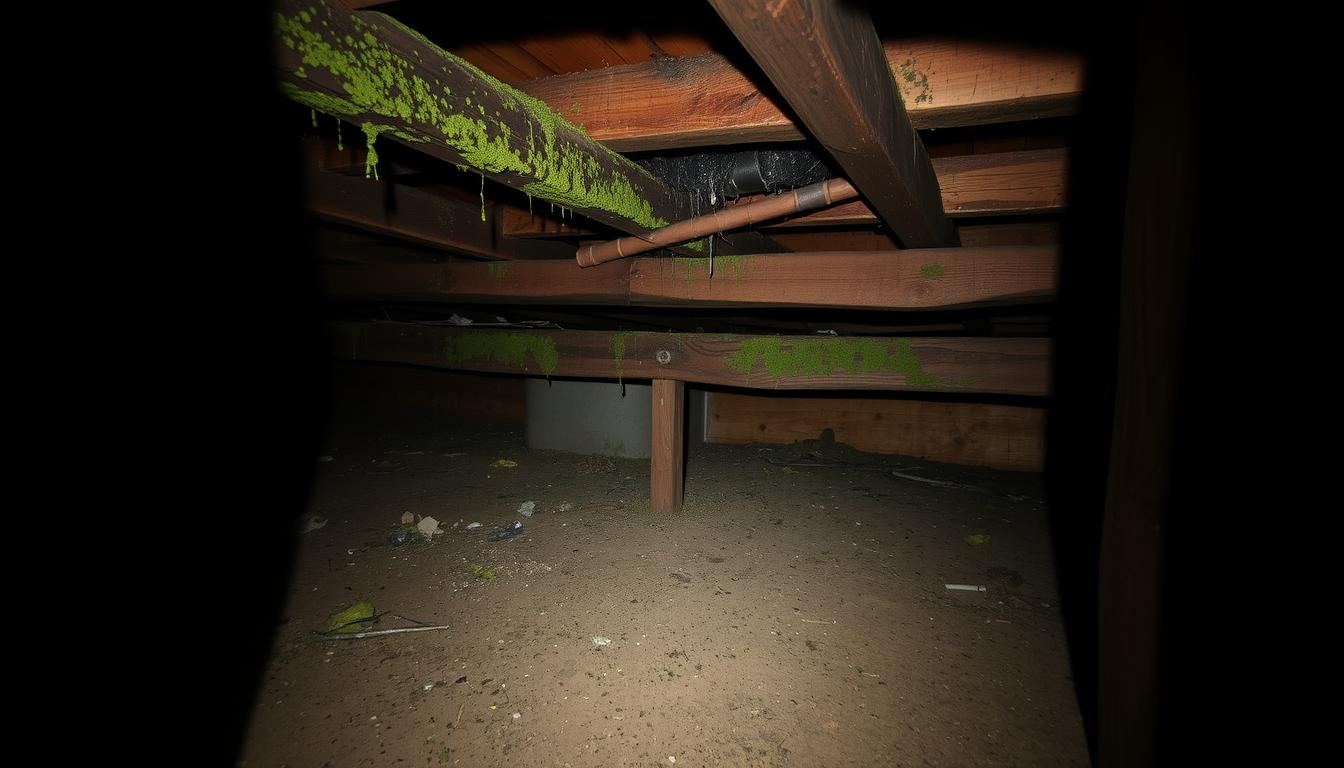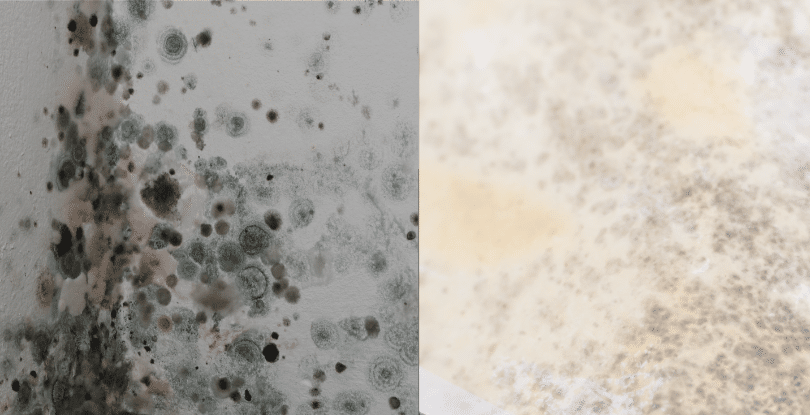Mold can cause big problems in homes, especially on floor joists in crawl spaces. In the U.S., 18% of homes have mold, often hidden in these damp areas. It’s important to tackle this issue because mold can harm your home and your health.
In this guide, I’ll give you expert advice and clear steps to remove mold from your crawl space. With the right methods and effort, you can make your home healthy again and keep it safe.
Key Takeaways
- Mold on floor joists in crawl spaces is a common problem that can cause structural damage and health issues.
- Identifying and addressing the source of moisture is crucial to preventing mold growth.
- Proper protective gear is essential when removing mold to avoid exposure to harmful spores.
- Using an anti-microbial cleaning solution and thorough drying are key steps in effective mold removal.
- Professional help may be necessary for extensive mold growth or complex remediation.
Identify the Source of Moisture
Before you can remove mold from your floor joists, find and fix the moisture source. Mold grows in damp places. So, solving the moisture problem is key to stopping mold from coming back. Check your crawl space for leaks or water damage that might be causing the issue.
Check for Leaks or Water Damage
Look around your floor joists for moisture signs. Look for water stains, discoloration, or dripping water. Check for cracks, gaps, or holes where water might get in. Fix any problems you find to stop more moisture and mold.
Improve Ventilation
Bad ventilation in your crawl space can lead to too much moisture. This is perfect for mold. Learn about crawl space ventilation to improve airflow. Good ventilation helps control moisture and stops mold.
| Moisture Control Strategies | Mold Prevention Tactics | Crawl Space Ventilation Tips |
|---|---|---|
| – Identify and repair leaks or water damage – Install a vapor barrier to prevent moisture intrusion – Use a dehumidifier to maintain appropriate humidity levels | – Regularly inspect for signs of mold growth – Address moisture issues promptly to prevent mold development – Consult with a professional mold remediation company if necessary | – Ensure adequate airflow by opening vents or installing fans – Seal any cracks or openings to prevent outside air from entering – Consider installing a mechanical ventilation system for optimal control |
By fixing moisture problems in your crawl space, you can remove mold from your floor joists. This stops mold from coming back. Being proactive about moisture and mold is important for a healthy home.
Wear Protective Gear
Before starting to remove mold from your crawl space, put on the right gear. Mold can release spores that are harmful if breathed in. To keep yourself safe, wear a Tyvek suit, an N-95 mask, gloves, and goggles.
This outfit will protect you from mold spores and cleaning chemicals. It’s important to wear this gear to avoid health problems.
Mold can cause allergic reactions, asthma attacks, skin rashes, and breathing issues. Wearing the right protective equipment helps you protect from mold exposure. It makes the crawl space mold remediation process safe and effective.
PPE recommended for DIY mold removal in crawl spaces includes OSHA-rated respirator, non-vented goggles, gloves, and coveralls.
When dealing with mold removal crawl space projects, be cautious. Taking the right precautions keeps you healthy and prevents more mold. So, get ready to face that mold with the right gear!
Practice Source Removal
Getting rid of mold on floor joists in your crawl space is key. First, use an antimicrobial cleaning solution. Then, remove the mold by scrubbing and wiping it away.
Scrub Thoroughly with a Brush
Start by scrubbing the affected floor joists with a sturdy brush. Make sure to get into all areas where mold has grown. This will help remove the mold.
Be ready to work hard. Scrub until the mold is gone.
Wipe Down with a Damp Cloth
After scrubbing, use a damp cloth to wipe down the area. This removes any leftover mold spores or residue. Make sure to rinse and wring out the cloth often.
By removing the floor joist mold this way, you’re on the path to a mold removal crawl space. This will also help prevent future crawl space mold remediation problems. A thorough approach is crucial for solving the mold issue at its source.
Use an Anti-Microbial Cleaning Solution
When dealing with mold on floor joists in your crawl space, an anti-microbial cleaning solution is key. These products are made to remove mold and kill the fungus that causes it. They help prevent mold from coming back. Choose commercial mold-killing solutions for safe and effective mold remediation in crawl spaces.
Apply Solution and Let it Sit
Start by applying the anti-microbial solution to the moldy areas. You can use a bleach-based cleaner like RMR-86 or an eco-friendly option like Benefect. Make sure to let it sit for at least 15 minutes. This lets the solution deeply penetrate and kill the floor joist mold, making cleaning easier.
Don’t use just bleach and water. There are safer, more effective options for mold removal crawl space. By letting the solution work, you’ll get a thorough mold removal.
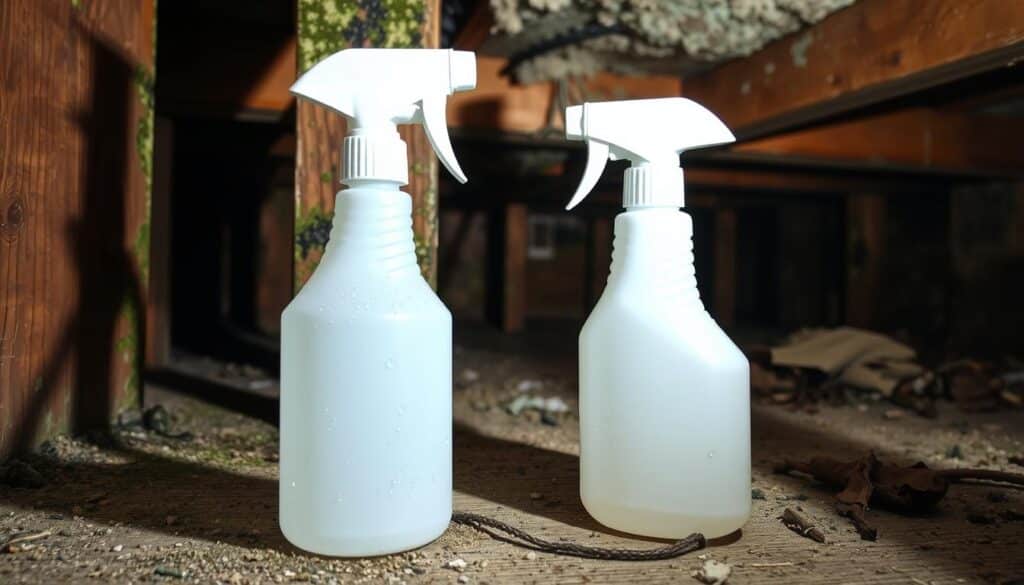
The key to successful crawl space mold removal is using the right cleaning solution and allowing it to work its magic before scrubbing and wiping down the affected areas.
Dry the Air
After removing mold from your crawl space, it’s key to dry it well to stop mold from coming back. You need to close the crawl space vents and use a dehumidifier for the crawl space.
Close Crawl Space Vents
Keeping the crawl space vents closed helps keep the area dry. This is vital for moisture control and mold prevention in the crawl space.
Use a Dehumidifier
Choosing a good dehumidifier for crawl spaces is important. Look for ones that save energy, have automatic shut-off, and remove moisture well. Low humidity stops mold from growing.
Proper air drying is key in fixing mold problems. Fixing moisture issues in your crawl space keeps mold away. This protects your home and family’s health for a long time.
Common Causes of Crawl Space Mold
Crawl spaces and basements are often breeding grounds for mold. This is because they are prone to dampness and poor ventilation. Several factors contribute to mold growth, including water damage, flooding, and a lack of proper moisture control.
Dampness and Lack of Ventilation
Mold loves damp, dark places, and crawl spaces are perfect for it. Without enough ventilation, humidity levels rise. This, combined with cool temperatures, leads to water on building materials. This is a perfect setting for mold to grow and spread.
Water Damage and Flooding
Leaks, plumbing issues, or flooding can bring a lot of water into a crawl space. This water can soak building materials, creating a mold-friendly environment. Water damage and flooding are common causes of mold in crawl spaces, leading to costly remediation.
To prevent and address mold in crawl spaces, it’s essential to identify and address the root causes. This includes moisture control, ventilation, and water intrusion. Proper crawl space maintenance, including regular inspections and prompt repairs, can help keep mold away. It also protects your home’s health and structure.
| Cause | Description |
|---|---|
| Dampness and Lack of Ventilation | Inadequate ventilation leading to high humidity and condensation, creating an ideal environment for mold growth. |
| Water Damage and Flooding | Leaks, plumbing issues, or flooding introducing significant amounts of water into the crawl space, saturating building materials and promoting mold development. |
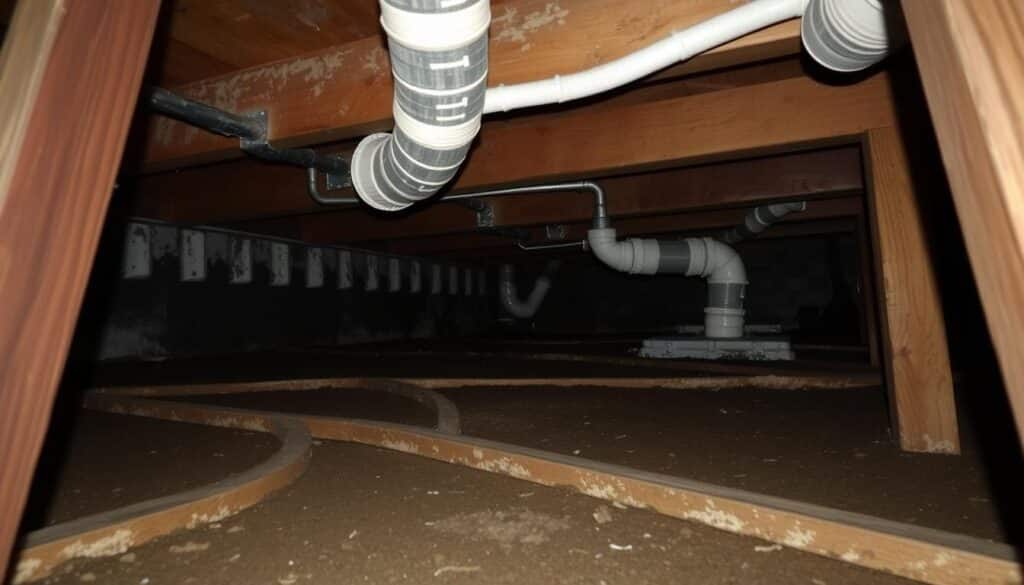
“Mold in crawl spaces is reported as one of the most common problems in homes with this foundation type.”
By understanding the common causes of mold in crawl spaces and taking proactive steps, homeowners can keep their homes healthy and mold-free. This avoids the costly and time-consuming process of mold remediation.
Protecting Yourself During Mold Removal
When you suspect mold in your crawl space, safety is key. Mold spores can harm you if you breathe them in or touch them. So, wearing the right gear is essential. It helps protect you from mold exposure and makes the removal process safe.
Wear Proper PPE
To keep yourself safe during crawl space mold remediation, make sure to wear:
- Goggles or other eye protection to shield your eyes from mold spores
- Disposable gloves to prevent skin contact with mold
- An N-95 mask or respirator to filter out harmful mold particles and prevent inhalation
These steps help minimize the risks associated with mold removal safety. They let you work on the job without risking your health.
“Proper PPE is essential when working with mold. It’s the first line of defense in protecting your health and well-being during the remediation process.”
By focusing on your safety and wearing the right PPE, you can safely tackle mold in your crawl space. This makes the remediation thorough and effective. Always remember, your health and safety are the top priority when dealing with mold.
DIY Mold Removal Methods
Dealing with mold in your crawl space can be tough. But, there are DIY methods for small areas. Using a vinegar solution is one of the best DIY options.
Vinegar Solution
Vinegar is great at killing mold because it’s a natural antimicrobial. Mix equal parts white vinegar and water in a spray bottle. Spray it on the moldy areas.
Let it sit for at least an hour. Then, scrub the area with a stiff brush. Finally, wipe it down with a damp cloth to get rid of any leftover residue.
Baking Soda
Baking soda is another good choice for DIY mold removal. Mix baking soda and water to make a paste. Apply it to the moldy spots.
Let it sit for a few hours. Then, scrub and wipe down the surface.
Borax
Borax is a natural mineral that works well for crawl space mold remediation. Mix one cup of borax with a gallon of water. Apply it to the moldy areas.
Let it sit for several hours. Then, scrub and rinse the surface.
While DIY methods can help with small floor joist mold treatment cases, they might not be as effective as professional help. Mold can come back if you don’t fix the moisture problem. If the mold is big or you’re not sure about removing it, get a professional mold remediation specialist.
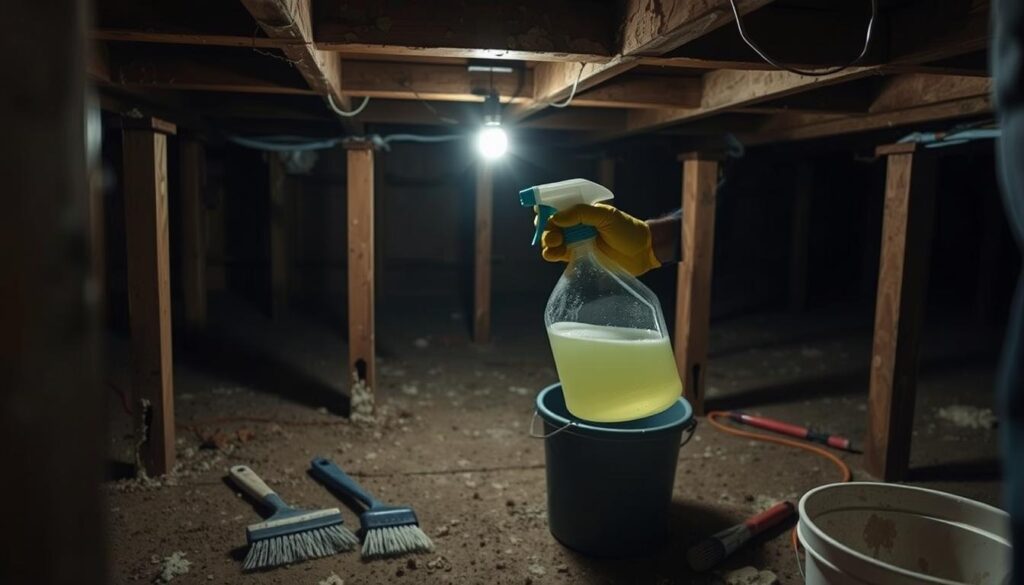
How to Get Rid of Mold on Floor Joists in Crawl Space
Mold is a common problem in homes, especially on floor joists in crawl spaces. It can cause structural damage. To remove mold, find and fix the moisture source, wear protective gear, and use the right cleaning methods.
First, find the moisture source that lets mold grow. Look for leaks or water damage in the crawl space. Make sure there’s good ventilation to stop mold from coming back.
- Wear a Tyvek suit, N-95 mask, gloves, and goggles to protect yourself from harmful mold spores.
- Use an antimicrobial cleaning solution and let it sit for at least 15 minutes to reduce the mold and make it easier to remove.
- Thoroughly scrub the affected areas with a brush and wipe down with a damp cloth to remove any remaining mold.
- Close the crawl space vents and use a dehumidifier to dry the air and prevent future mold growth.
Fixing the moisture problem and cleaning well are key to removing mold from floor joists. If the mold is bad or you’re not comfortable doing it, get a professional mold remediation service.
| Mold Removal Method | Effectiveness | Cost |
|---|---|---|
| Vinegar Solution | Moderate | Low |
| Baking Soda | Moderate | Low |
| Borax | High | Moderate |
| Professional Mold Remediation | High | High |
Mold can release harmful spores that may cause health problems. So, it’s important to be careful when removing it. By fixing moisture and using the right cleaning, you can get rid of mold on floor joists and keep it away.
Preventing Future Mold Growth
It’s important to prevent mold in your mold prevention crawl space. Keeping moisture levels down is key. This helps keep crawl space encapsulation mold away.
Insulate and Ventilate
Insulation and ventilation are vital for a dry, mold-free crawl space. Insulating walls and using a dehumidifier for crawl space helps control humidity. Good air flow through vents or fans also stops moisture buildup.
Professional Mold Remediation
If you face a big mold problem, consider a professional. They have the skills and tools to fix it right. They can also find and fix the mold’s cause, keeping your space healthy.
Acting early on mold prevention crawl space issues is crucial. Insulate, ventilate, and get help when needed. This keeps your home safe from mold’s harm.
Conclusion
To get rid of mold on your crawl space’s floor joists, you need a careful plan. First, find and fix the moisture problems. Then, wear the right protective gear and use effective cleaning methods. Remember, being patient and detailed is crucial to remove mold and stop it from coming back.
Improving ventilation and controlling humidity are key steps. Using antimicrobial solutions and drying the area well are also important. This guide shows how to keep your crawl space mold-free. With the right tools and knowledge, you can beat mold and keep your home safe.
Keeping your crawl space healthy is a smart move for your home’s value and air quality. By tackling mold early, you can live in a cleaner, healthier space. This effort will give you peace of mind and a safer home.
FAQ
How do I identify and address the source of moisture in my crawl space?
First, look for any leaks or water damage. If you find any, fix the joists. Also, improve ventilation to stop moisture buildup.
What type of protective gear should I wear when removing mold from floor joists?
Wear a Tyvek suit, N-95 mask, gloves, and goggles. This protects you from mold spores and cleaning chemicals.
What is the best way to remove mold from the floor joists?
Use an antimicrobial cleaning solution and a scrub brush. Clean all affected areas. Then, wipe with a damp cloth to remove spores.
Can I use bleach to kill the mold?
No, avoid bleach and water. Instead, use safer commercial mold killing solutions.
How can I prevent the mold from coming back?
After cleaning, dry the area well. Close crawl space vents and add a dehumidifier to lower moisture.
What are common causes of mold growth in crawl spaces?
Mold grows from water damage, flooding, and plumbing leaks. It also comes from poor ventilation, drainage, and foundation cracks.
Can I use DIY methods to remove the mold?
Yes, vinegar, baking soda, or borax can help with small mold issues. But, for big problems or if moisture isn’t fixed, get professional help.


